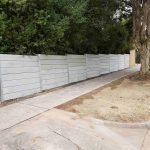Introduction
Retaining walls play an essential role in landscaping and building and construction, especially in areas vulnerable to disintegration or where modifications in elevation take place. The value of hiring a certified retaining wall contractor can not be overemphasized. Whether you're thinking about a timber sleeper keeping wall, a concrete sleeper maintaining wall, or even a brick maintaining wall, understanding the complexities involved can conserve you time, money, and future headaches. This short article looks into the diverse role of a retaining wall installer near you, supplying insights that will empower homeowners and home designers alike.
Understanding the Function of a Retaining Wall Installer Near You
When you think about landscaping, it's easy to ignore the necessary structural components that contribute to its beauty and efficiency. A retaining wall installer is not just a worker; they are proficient specialists who understand soil mechanics, drainage systems, and visual style principles. They ensure that your keeping walls serve their purpose while enhancing your property's appeal.
What is a Keeping Wall?
A retaining wall is an engineered structure designed to keep back soil and prevent disintegration. It can be made from different products such as timber, concrete, brick, or stone. The choice of material typically depends on aspects like aesthetics, cost, and ecological conditions.
Why Do You Required a Keeping Wall?
- Erosion Control: Prevents soil from washing away throughout heavy rains. Land Utilization: Permits the creation of flat locations on sloped land. Aesthetic Appeal: Improves landscape design with innovative options. Property Value Increase: A well-designed retaining wall can elevate your property's market value.
The Significance of Hiring Resident Experts
Choosing a local retaining wall professional near you guarantees that they are familiar with local guidelines, soil conditions, and environment obstacles. This localized proficiency can make all the distinction in developing https://tuffstuffretainingwalls.com.au/ a long lasting and efficient structure.
Types of Retaining Walls
Timber Sleeper Retaining Walls
Timber sleeper walls are popular due to their cost-effectiveness and natural look. However, they need correct treatment to resist moisture and insects.
Advantages:
- Cost-effective Aesthetic appeal Easy installation
Disadvantages:
- Limited lifespan Susceptible to rot
Concrete Sleeper Retaining Walls
Concrete sleepers supply durability and strength. They are ideal for much heavier loads however might require professional setup due to their weight.
Advantages:
- Long-lasting Strong structural integrity Low maintenance
Disadvantages:
- Higher initial cost Limited design alternatives compared to timber
Brick Retaining Walls
These walls offer timeless sophistication but need more know-how throughout installation.
Advantages:
- Aesthetic versatility Durability Fire-resistant
Disadvantages:
- Higher labor costs More complex building process
Stone Keeping Walls
Natural stone offers unequaled charm but includes higher expenses and requires knowledgeable labor for appropriate installation.
Advantages:
- Unique and classy appearance Extremely durable
Disadvantages:
- High product costs Requires professional craftsmanship
The Process of Retaining Wall Installation
1. Preliminary Consultation
Before any work starts, it's essential to discuss your needs with your selected professional. Throughout this phase, they'll evaluate your property, recognize possible obstacles, and recommend appropriate materials.
2. Site Preparation
Proper site preparation consists of clearing vegetation, grading the land, and guaranteeing adequate drain systems remain in place.
3. Product Selection
The choice in between timber, concrete, brick or stone will depend on different factors including budgetary constraints and visual preferences.
4. Building and construction Phase
This involves laying the foundation stones or blocks according to engineering concepts that ensure stability versus lateral earth pressures.
5. Backfilling & & Drainage Installation
After constructing the wall itself, it is necessary to backfill with gravel or sand for appropriate drainage-- a key consider prolonging the life of your retaining wall.
Key Factors to consider Before Working with a Retaining Wall Installer Near You
1. Experience Matters
Look for installers with tested experience in various kinds of maintaining walls-- this speaks volumes about their capability.
2. Portfolio Review
Ask for examples of previous work; this will offer you insight into their style and quality standards.
3. Licensing & & Insurance
Ensure that your chosen professional has appropriate licenses and insurance protection for peace of mind throughout the project.
FAQs About Retaining Wall Installers
Q1: Just how much does it usually cost to install a keeping wall?
A1: Costs differ commonly based on products used(lumber vs concrete ), height requirements, labor charges, and site conditions however anticipate anywhere from$15 -$50 per square foot.
Q2: How long does it require to install a keeping wall?

Q3: Can I install my own retaining wall?
A3: While do it yourself is possible for smaller projects using lumber sleepers or basic designs-- professional help is recommended for larger structures due to safety concerns related to stability & local codes.
Q4: What permits do I require for constructing a keeping wall?
A4: This differs by region; check local zoning laws concerning height limitations & structural requirements before proceeding with building and construction plans.
Q5: What kind of upkeep do & these walls require?
A5: Routine inspections for drain issues & repair work as needed make sure durability; maintenance requires depend mostly on the type picked(e.g., wood may need staining/sealing ).
Q6: Where can I find credible professionals near me?
A6: Online directory sites like Yelp or Angie's List offer consumer reviews; word-of-mouth recommendations from next-door neighbors are likewise advantageous sources!
Conclusion
In essence, understanding the function of a retaining wall installer near you is vital when preparing any landscaping project involving elevation changes or disintegration control solutions. From picking the right material-- be it timber sleeper retaining walls or robust concrete alternatives-- to making sure correct setup practices are followed by certified regional professionals-- the result considerably impacts both performance and aesthetic value over time.
Investing time upfront into research pays dividends later when enjoying durable structures that stand strong against nature's forces while enhancing outdoor home perfectly! For that reason always prioritize hiring expert specialists who can efficiently equate your vision into truth while sticking strictly to market standards-- because at the end of day absolutely nothing beats peace-of-mind understanding you've made educated choices!